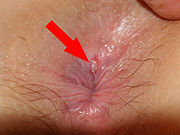
Digestion & Digestive Health - Imperforate Anus (anal atresia)
Imperforate Anus
An imperforate anus or anal atresia is a birth defect in which is characheterized by malformed rectum or the absence of a normal anal opening. The anus is the opening to the rectum through which stools leave the body.
The diagnosis is usually made shortly after birth by a routine physical examination. Imperforate anus occurs in about 1 in 5000 births and its cause is unknown.
Imperforate anus or anal atresia is a congenital abnormality in which the anorectal region is abnormal or incompletely developed. In some cases, the rectum may end and not connect with the anus, or it may connect in the wrong spot. For example, it may connect to the urethra, bladder, or vagina. (See the section on fistulas).  In other cases, the anus may be very narrow or missing altogether. The result is that stool cannot pass out of the colon. Imperforate anus occurs in about 1 in 5,000 infants. nother malformation that results in absence of a functioning anus is congenital cloaca. In patients with this abnormality, the anal muscles and vagina fail to form and the result is a large, ill-defined opening that represents the rectum as well as the vagina and bladder, depending on the extent of the defect. Cloaca deformity of the anus usually requires a colostomy but may be correctable with a surgical procedure that transfers a muscle from another part of the body to create a functioning sphincter at the anus.
In other cases, the anus may be very narrow or missing altogether. The result is that stool cannot pass out of the colon. Imperforate anus occurs in about 1 in 5,000 infants. nother malformation that results in absence of a functioning anus is congenital cloaca. In patients with this abnormality, the anal muscles and vagina fail to form and the result is a large, ill-defined opening that represents the rectum as well as the vagina and bladder, depending on the extent of the defect. Cloaca deformity of the anus usually requires a colostomy but may be correctable with a surgical procedure that transfers a muscle from another part of the body to create a functioning sphincter at the anus.
Following symptoms may indicate this condition:
- Anal opening very near the vaginal opening in girls
- Missing or misplaced opening to the anus
- No passage of first stool within 24 - 48 hours after birth
- Stool passes out of the vagina, base of penis, scrotum, or urethra
- Swollen belly area
A doctor can diagnose this condition during a physical examination. Imaging tests may be recommended. As with most birth defects, there is no known prevention.